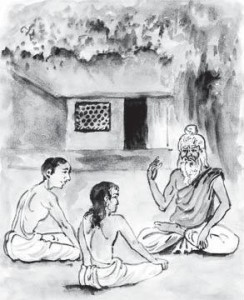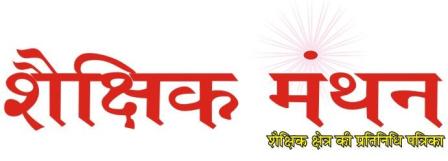Education in the Vedic Age

If we want to trace the roots of
Bharatheeya Education system, we
have to go back thousands of years in
the time line, known as vedic age. It is
the age in which the four Vedas,
Brahmanas, Aranyakas, and
Upanishads flourished. In these sacred
texts we find our ancient system of
education.
In this system, education was
not just collecting information and
vomiting it in the examination hall. On
the other hand it was giving
satsanskaras to shareera, mana and
buddhi. Education was aimed at moulding
the young pupils as individuals,
capable of living principles of a perfect
and full life based on the Dharma.
A well known scholar,
Chidambara Kulkarni has briefly put
it, “The ancient Indian system of education
was … a comprehensive scheme
of perfecting the individuals’ personality
in all its facts – physical,
mental,intellectual , religious and spiritual”
(vedic foundations of Indian culture
, Bombay: Shri Davipayana Trust,
1973, P.107) Knowledge in this system
is not confined to only the intellect,
but it is actual realization of ‘self’
and it must reveal itself through
thought word and deed, as
Brihdaranyaka Upanisad puts it
“Shravana, Manana and
Nididhyasana”.
To give such a ‘samskara’ a
peaceful atmosphere unpolluted with
‘vasanas’ was the basic need. So the
ancient learning centers were largely
located for away from the din and
bustle of cities in sylvan retreats, in an
atmosphere of solitude and serenity
condusive to mental concentration as
the main appliance in education. The
second important factors in Bharateeya
education came from the teacher-
Acharya- as the master mind directing
the entire course. His home was the
school. The banyan or Aswattha tree
near the Ashram was the class room.
The school was a natural formation and
not an artificially created institution.
In a way every Ashram was a residential
school.
The pupils who were interested
in learning came in search of the
Acharya. The caste, creed or the economic
status was not the criteria to
admit a pupil. The desire for knowledge
was the only criteria.
There is a story in Chandyoga
Upanisad . Satya Kama was the son of
Jabali. Jabali was an women of lower
strata. Satya Kama went to Rishi
Gauthama’s hermitage and sought his
shelter. Maharshi Gauthama enquired
about his parentage. The small boy
Satya Kama went to his mother and
❑ H. Nagabhushana Rao
I
asked about his father, his Gotra and
other details. Jabali told that, she was
a maid servant and was serving many
people, as such she is not aware of
his father and his gotra. She asked
her son to narrate the same to the
Acharaya. Acharya Gouthama was
pleased to hear the truth and took
him as his student and bestowed all
the knowledge. Satyakama himself
became a Rishi known as Satyakama
Jabali .
Similarly Sudhama a poor Brahmin
boy and Sri Krishna the son of
Yadava king studied together in Rishi
Sandeepini’s Asharama. Drona and
Drupada a poor and a rich also were
classmates in the Ashrama.
As I already mentioned there
were 3 steps for learning.
